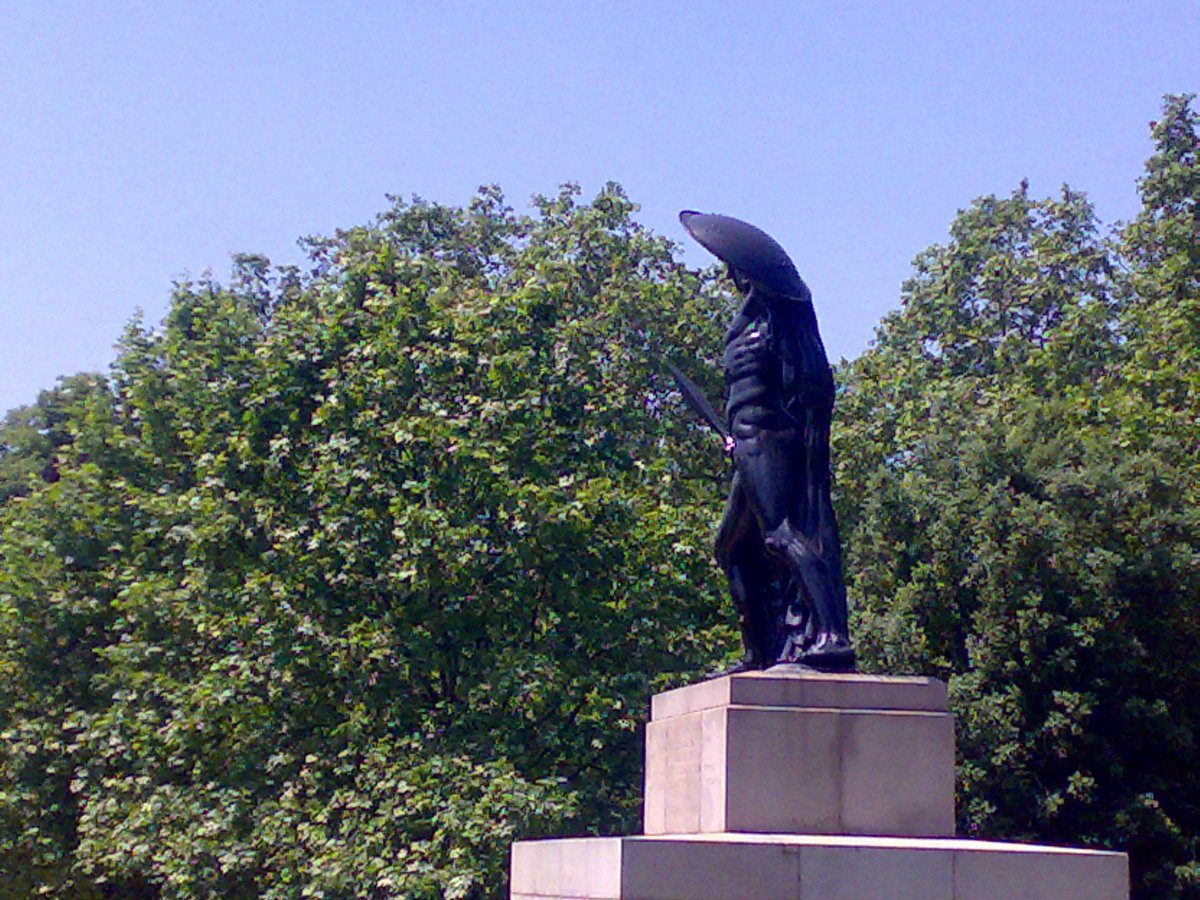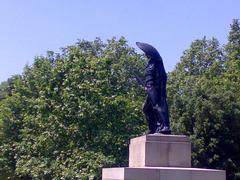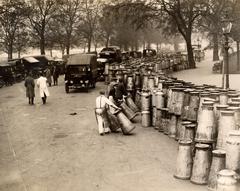
Visiting Hyde Park, London: United Kingdom Guide — Tickets, Hours, and Attractions
Date: 03/07/2025
Hyde Park, at the heart of London, is one of the world’s most famous urban parks. With nearly 500 years of history, it offers visitors a remarkable blend of natural beauty, cultural significance, and vibrant events. This detailed guide covers Hyde Park’s history, key attractions, practical visitor information, and tips for making the most of your time in this iconic green space.
Table of Contents
- Introduction and History
- Key Historical Phases
- Political and Social Significance
- Memorials and Landmarks
- Visiting Hyde Park: Hours, Tickets, and Accessibility
- Getting There: Transport and Parking
- Facilities and Amenities
- Events and Seasonal Highlights
- Travel Tips and Nearby Attractions
- Hyde Park FAQs
- Conclusion
- References
Introduction and History
Hyde Park is a central and cherished part of London, spanning about 350 acres and adjoining Kensington Gardens. Established in 1536 by King Henry VIII as royal hunting grounds, its transformation into a public park in 1637 under King Charles I marked a pivotal moment in the democratization of urban spaces in London. Today, Hyde Park is renowned not only for its picturesque landscapes but also for its role as a venue for recreation, political expression, and major public events (Londontopia; PlanetWare).
Key Historical Phases
Tudor Origins
Hyde Park began as the Manor of Hyde, acquired from Westminster Abbey by Henry VIII during the Dissolution of the Monasteries. Initially a private deer park, it reflected the exclusivity of royal recreation in the Tudor era (Londontopia; Wikipedia).
In 1637, King Charles I opened Hyde Park to the public, laying the foundation for its enduring role as a gathering place for Londoners (Signature Townhouse; TravelSetu).
18th Century Transformation
Under Queen Caroline, Hyde Park underwent major landscaping improvements, notably the creation of the Serpentine Lake in the 1730s. The Serpentine became a center for leisure activities, including boating and swimming, which remain popular today (Freetoursbyfoot).
Rotten Row, originally a royal riding track, gained fame as a fashionable promenade for the upper classes (Wikipedia).
Victorian Era and the Great Exhibition
Hyde Park’s international profile soared in 1851 when it hosted the Great Exhibition, held in the Crystal Palace. The event drew over six million visitors, showcasing British industrial achievements and solidifying the park’s status as a major public venue (Britannica; Art UK).
Political and Social Significance
Speakers’ Corner
Established in 1872 at the park’s northeast corner (near Marble Arch), Speakers’ Corner has become a global symbol of free speech. It is a platform for public debate and activism, attracting speakers from Karl Marx to George Orwell, and remains lively on Sundays (London Kensington Guide).
Demonstrations and Civic Gatherings
Hyde Park’s vast open spaces have hosted significant demonstrations and rallies, from suffragette marches to anti-war protests, reflecting its pivotal role in British civic life (PlanetWare).
Memorials and Landmarks
Hyde Park is home to a variety of memorials reflecting the nation’s history:
- Diana, Princess of Wales Memorial Fountain: A modern, interactive memorial honoring Diana’s legacy (Royal Parks – Diana Memorial Fountain).
- 7 July Memorial: Commemorates victims of the 2005 London bombings.
- Cavalry Memorial: Honors British cavalry regiments.
- Animals in War Memorial: Recognizes animal contributions in military conflicts.
- Achilles Statue: Celebrates the Duke of Wellington’s victories.
- Peter Pan Statue: A whimsical tribute to J.M. Barrie’s literary character.
- Serpentine Lake and Bridge: Central to park life, offering boating and scenic strolls (YourGuidesAbroad).
- Rose Garden: A beautifully landscaped area blooming in late spring and early summer.
The park also features contemporary art spaces, such as the Serpentine Galleries, hosting acclaimed exhibitions (London Kensington Guide).
Visiting Hyde Park: Hours, Tickets, and Accessibility
- Opening Hours: Daily, 5:00 AM to midnight (Wikipedia).
- Entry: Free to all. Tickets required only for special events (e.g., British Summer Time festival, Winter Wonderland) (BST Hyde Park).
- Accessibility: Wheelchair-friendly paths, accessible toilets, and inclusive event policies. Assistance dogs are welcome, and mobility scooters can be hired (BST Hyde Park Accessibility).
- Family Facilities: Playgrounds, educational Discovery Days, and picnic areas.
Getting There: Transport and Parking
- Underground Stations: Hyde Park Corner (Piccadilly), Marble Arch (Central), Lancaster Gate (Central), Knightsbridge (Piccadilly), and Paddington (mainline + Underground).
- Buses: Multiple routes stop around the park’s perimeter.
- Cycling: Santander Cycles docking stations and designated bike paths (The Tourist Checklist).
- Parking: Limited pay-and-display spaces and Blue Badge accessible spots. Public transport is strongly recommended due to congestion (BST Hyde Park Info).
- From Heathrow: Heathrow Express to Paddington, then a short walk or taxi.
Facilities and Amenities
- Toilets: Multiple public and accessible facilities, with extras during large events.
- Cafés: Serpentine Bar & Kitchen, Lido Café, and refreshment kiosks (Royal Parks – Visitor Amenities).
- Shop: The Royal Parks Shop (10am–6pm) for souvenirs and gifts.
- Deckchairs: Available for hire in summer.
- Lost Property: Report at park offices or event services.
Events and Seasonal Highlights
- British Summer Time (BST) Hyde Park: Annual music festival with global stars and family events. Tickets via BST app (BST Hyde Park Info; Time Out).
- Winter Wonderland: Festive markets, ice skating, rides, and seasonal entertainment. Entry is free, some attractions ticketed (London Sightseeing).
- Guided Tours: Available year-round, covering history, ecology, and art (Royal Parks – Hyde Park Activities).
Travel Tips and Nearby Attractions
- Best Time to Visit: Spring and summer for flowers and outdoor activities; winter for festive attractions.
- What to Bring: Comfortable shoes, weather-appropriate clothing, reusable water bottle, and a camera.
- Rules: No barbecues, keep dogs leashed in designated areas, and dispose of litter properly.
- Nearby Sights: Kensington Palace, Buckingham Palace, Royal Albert Hall, Natural History Museum, and Victoria and Albert Museum (TravelSetu).
Hyde Park FAQs
Q: What are Hyde Park’s opening hours?
A: Daily, 5:00 AM to midnight.
Q: Is there an entry fee?
A: Entry is free. Tickets are required for certain events.
Q: Are dogs allowed?
A: Yes, but must be under control. Leads required in some zones.
Q: Is Hyde Park accessible for wheelchairs?
A: Yes, with paved paths and accessible facilities.
Q: Where can I rent a boat?
A: At the Serpentine Boating Centre during warmer months.
Q: How do I reach Hyde Park from Heathrow?
A: Heathrow Express to Paddington, then walk or taxi.
Conclusion
Hyde Park is a living emblem of London’s evolution—from royal hunting grounds to a vibrant public space at the center of city life. With its free access, inclusive amenities, and a calendar full of world-class events, Hyde Park is a must-visit for anyone exploring London’s historical sites and green spaces. Whether you seek relaxation, cultural experiences, or active adventures, the park offers something for everyone. Plan your visit using this guide and enjoy all that Hyde Park has to offer.
For the latest updates, interactive maps, and event news, download the Audiala app and follow Hyde Park on social media.
References
- Hyde Park: A Historical Overview and Visitor’s Guide to One of London’s Most Iconic Parks, 2024, Londontopia (https://londontopia.net/parks/the-history-of-londons-hyde-park-from-royal-hunting-grounds-to-political-soapbox/)
- Hyde Park Visiting Hours, Tickets & London’s Historic Green Space Guide, 2024, PlanetWare (https://www.planetware.com/london/hyde-park-eng-l-hy.htm)
- Hyde Park Visiting Hours, Tickets & London’s Historic Green Space Guide, 2024, London Kensington Guide (https://www.londonkensingtonguide.com/things-to-do-hyde-park/)
- Hyde Park: A Historical Overview and Visitor’s Guide to One of London’s Most Iconic Parks, 2024, Britannica (https://www.britannica.com/place/Hyde-Park-London)
- Hyde Park Visiting Hours, Tickets & London’s Historic Green Space Guide, 2024, BST Hyde Park Official (https://www.bst-hydepark.com/info-details/general-info/)
- Exploring Hyde Park: Visiting Hours, Tickets, and Must-See London Historical Sites, 2024, Royal Parks (https://www.royalparks.org.uk/visit/parks/hyde-park/things-to-do)
- Exploring Hyde Park: Visiting Hours, Tickets, and Must-See London Historical Sites, 2024, Central Park Collection (https://centralparkcollection.co.uk/why-is-hyde-park-london-famous/)
- Visitor Information and Practical Tips for Hyde Park: Opening Hours, Tickets, Accessibility & Nearby Attractions, 2024, London Sightseeing (https://london-sightseeing.net/hyde-park-visitors-guide/)
- Visitor Information and Practical Tips for Hyde Park: Opening Hours, Tickets, Accessibility & Nearby Attractions, 2024, The Tourist Checklist (https://thetouristchecklist.com/things-to-do-in-hyde-park/)
- Visitor Information and Practical Tips for Hyde Park: Opening Hours, Tickets, Accessibility & Nearby Attractions, 2024, BST Hyde Park Accessibility (https://www.bst-hydepark.com/info-landing/)
- Hyde Park Visiting Hours, Tickets & London’s Historic Green Space Guide, 2024, Time Out (https://www.timeout.com/london/music/bst-hyde-park)





















































































































































































































































